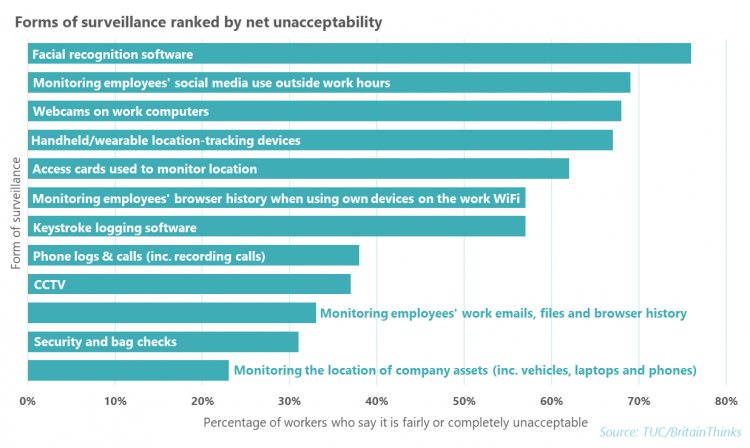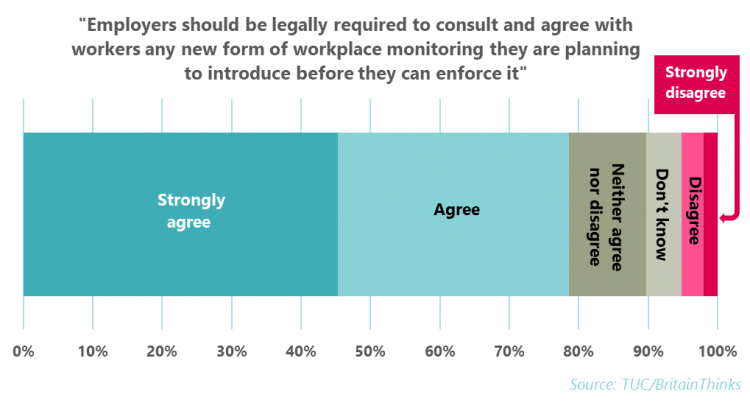
Is your boss watching your every move?
Ever feel like you’re being watched at work?
If you’re a worker in the UK you’re not being paranoid. You’re probably right.
According to new research we release today, most workers (56 per cent) now think it’s likely their employer is monitoring them at work.
From trawling social media to tracking toilet breaks, we’ve found that more and more bosses are snooping on their staff.
And as new technology becomes widely available, many workers are worried that workplace monitoring is only going to get worse.
That’s why we’re calling on employers only to use surveillance when it’s needed to protect workers, such as ensuring people can work safely.
And we want all workers to be informed of any new or existing monitoring arrangements and the reasons behind their use.
Intrusive surveillance undermines trust in the workplace by making people feel they’re always being watched.
So instead of tracking their workers’ every move, we want bosses to start engaging with staff and unions to make the working world a better place.
One worker told us that a previous employer would use surveillance to “manage people out” of the company
What is workplace monitoring?
A few decades ago, snooping bosses had to rely on timesheets and bag searches to keep an eye on their workforce.
But new technology allows today's employers to keep track of everything people do at work – and sometimes what they do outside it.
According to our research, the most common forms of workplace surveillance are:
- Monitoring work emails, files and work computer browsing history (49 per cent of workers we surveyed think this is fairly or very likely in their workplace)
- CCTV (45 per cent)
- Phone logs and calls, including recording calls (42 per cent)
And we also found that more and more bosses are using advanced forms of technology to monitor performance.
For example, 23 per cent of people think handheld or wearable location-tracking devices may be being used in their workplace, and as many as 15 per cent believe their employers are using facial recognition software.
Why is this a problem?
Workplace monitoring has become a part of daily life despite most workers finding it unacceptable – particularly if the surveillance is intrusive, invasive, or unjustified.
Take a look at the chart below, which shows which forms of surveillance people really don’t like:

We can see that over two thirds of workers think employers are crossing a line when they start snooping on social media feeds outside of work hours.
And forcing staff to wear location-tracking devices so that bosses can monitor their every move – including their toilet breaks – is also deeply unpopular.
This sort of invasive and intrusive monitoring sends a clear signal to workers that their boss doesn’t trust them.
That’s why a strong majority (65 per cent) believe the introduction of a new type of surveillance would damage trust between their employer and the workforce.
Also, trust works both ways – and plenty of working people don’t trust their employers to use surveillance data fairly.
Two-thirds (66 per cent) take the view that workplace monitoring could increase discrimination unless it’s carefully regulated, and only a very small minority think it won’t.
People also worry that surveillance will be used to micromanage staff out of the company. They fear that employers are stockpiling surveillance data so that it can be used to sack someone they dislike later on.
One worker told us that a previous employer would use surveillance to “manage people out” of the company:
They definitely used it to get rid of people. They could listen back through all your recordings to find the one mistake you made if they wanted.
What needs to change
We clearly need to some changes around surveillance at work.
Seven out of ten workers think workplace monitoring will be more common in the future, but only a minority (38 per cent) feel able to challenge the surveillance they feel uncomfortable with right now.
So it’s no surprise that the vast majority (79 per cent) of workers think employers should be legally required to consult their staff before using introducing a new form of surveillance:

And 81 per cent say bosses should have to provide a clear and understandable justification as to why they’re introducing a new form of workplace monitoring before rolling it out.
To make sure these changes happen, and address workers’ concerns about excessive and intrusive surveillance, we need new protections. These include:
- Employers should only use surveillance for legitimate reasons which protect the interests of workers, such as ensuring people can work safely.
- Where unions are recognised, they must agree any use of workplace surveillance.
- All workers in all workplaces must be informed of any monitoring arrangements and the reasons for their use.
- The Information Commissioner’s Office (ICO) code on employment practices should be updated to take account of new tech. And if employers don’t comply with the code, anyone who loses their job due to evidence gathered using surveillance should automatically be considered as unfairly dismissed.
To read all our recommendations, check out our full report on workplace surveillance here.
Stay Updated
Want to hear about our latest news and blogs?
Sign up now to get it straight to your inbox
